The Best Backcountry Ski Jackets of 2024
This article originally appeared on Outside
From windy summits to bountiful winter powder turns, the jacket you choose for your backcountry adventure has different attributes and strengths than your resort-oriented ski wear. How breathable it is, how much protection against the elements it gives you, and how easy it is to move in as you head up the skintrack all factor in heavily. We tapped our most experienced backcountry enthusiasts to use and abuse over 30 jackets designed for ski touring and high-output backcountry adventures. Here are our favorite pieces that performed well in whatever conditions we threw at them last season.
The Winners at a Glance
Unisex/Men's Jackets
Editor's Choice: Strafe Cham Jacket
Most Rugged: Dynafit Tigard Jacket
Most Streamlined: Ortovox Ravine 3L Jacket
Most Lightweight: Helly Hansen Odin BC Infinity Shell Jacket
Best Resort/Backcountry Crossover: The North Face Summit Tsirku Jacket
Best For Storm Skiing: Rab Khroma Diffuse GTX Pro Jacket
Women's Jackets
Best For Dry Climates: Orage Boulder Hybrid Jacket
Best For Wet Climates: Mountain Hardwear Routefinder GTX Jacket
Most Packable: Arc'teryx Alpha Jacket
The Reviews: The Best Backcountry Ski Jackets of 2024
Men's/Unisex Jackets
Editor's Choice: Strafe Cham Jacket ($589)
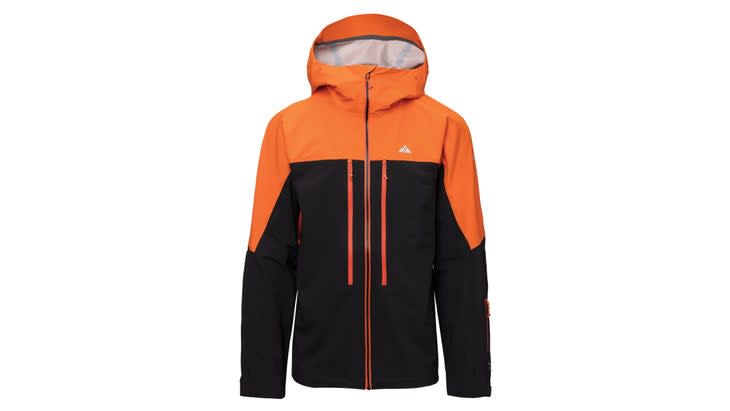
Weight: 15.2 oz
Sizes: XXS-XL
Pros:
Lightweight
Breathable
Cons:
Not the burliest waterproofing
With a name like the Cham Jacket, there's no surprise that this shell was one of our favorites for long days in the high alpine. The three-layer design constructed with Schoeller Aerobrane fabric boasted a ton of air permeability and an impressively soft and supple handfeel, staying on during long climbs with the occasional deployment of pit zips. "Spent plenty of time roughing up this jacket on rock scrambles as well as around crampons and ice axes, and was impressed with how well this light jacket held up," said tester Lily Krass. It tucked away neatly in our packs, and the simple pack-accessible chest pocket configuration stashed a phone and gummy bears on one side and skins on the other for quick transitions and on-the-go fuel. In truly harsh weather, it didn't compare to some of the burlier Gore-Tex Pro shells we tested, but for areas that see low-density snow and springtime skiing, this one is a keeper.
Bottom line: A versatile and lightweight shell for missions in the alpine
Most Rugged: Dynafit Tigard GTX Pro Jacket ($700)
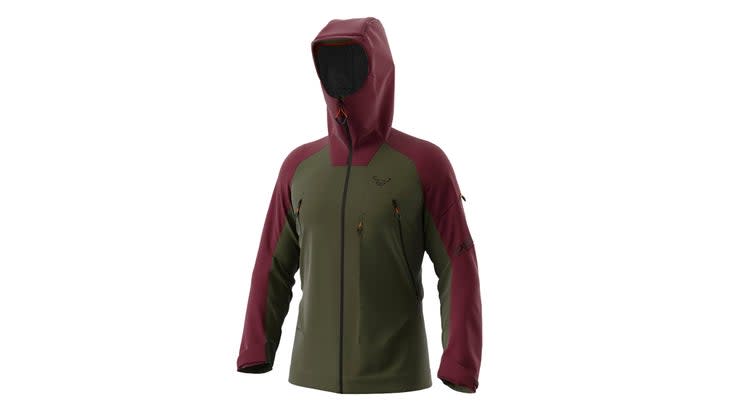
Weight: 1.4 lbs
Sizes: S-XXL
Pros:
Water resistance
Durability
Cons:
Packability
Runs very large
Dynafit certainly has a reputation for bright colors and snug uphill-focused clothing, so we were excited to see the skimo company branch out with a baggier freeride-inclined kit. The Tigard kit's muted colors and a spacious fit drew in testers who had "never been interested in Dynafit's vibe before," sporting a burly Gore-Tex Pro membrane while maintaining the lightweight design that Dynafit is known for. We were impressed with the bombproof nature of the Tigard; after roughing it up while scrambling along rocky bootpacks in Grand Teton National Park, we never saw so much as a scuff. "Dry and warm while the heaviest of snow was falling, and I fit the whole hood over my helmet and never felt the wind," said tester Lucy Iselin. Dynafit nailed it with the pocket configuration, with three chest pockets and a small inside pocket that made it easy to reach for gear without having to come to a stop. "There always seemed to be a pocket for whatever need I had," added Iselin. "Fit my skins on the outside pockets for a quick lap, but I could also stash gloves or goggles in there."
Bottom line: A burly shell with plenty of pockets to stash snacks and gear close by.
Most Streamlined: Ortovox Ravine 3L ($620)
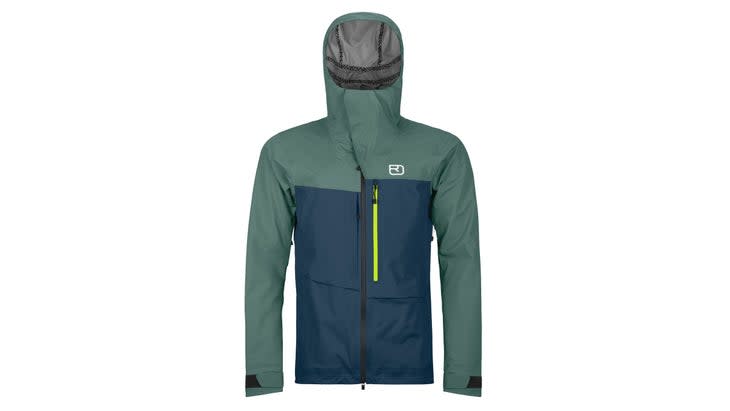
Weight: 1.1 lbs
Sizes: S-XXL
Pros:
Breathable
Weather protection
Cons:
Not a ton of pockets
We loved the new Ortovox Ravine kit this season for long days on the skintrack, keeping us dry during long slogs in Grand Teton National Park and pre-dawn laps on Teton Pass. A Merino layer paired with the water-shedding Dermizax NZ membrane made for an impressively breathable shell that testers kept on for stormy uptracks and windy bootpacks. "I don't usually like touring uphill in a shell but this is one I definitely didn't mind throwing on when it was snowing because it was breathable while still cutting the wind and moisture," said tester Lucy Iselin. The two chest pockets offered a little less space than most testers were used to (a few folks missed the waist pockets), but made up for it with a streamlined design that walked the perfect line of storm protection and packability. "A good all-around jacket to do it all," summed up tester James Temple.
Bottom line: A streamlined shell that's equally at home on deep powder days and spring missions
Most Lightweight: Helly Hansen Odin BC Infinity Shell Jacket ($650)
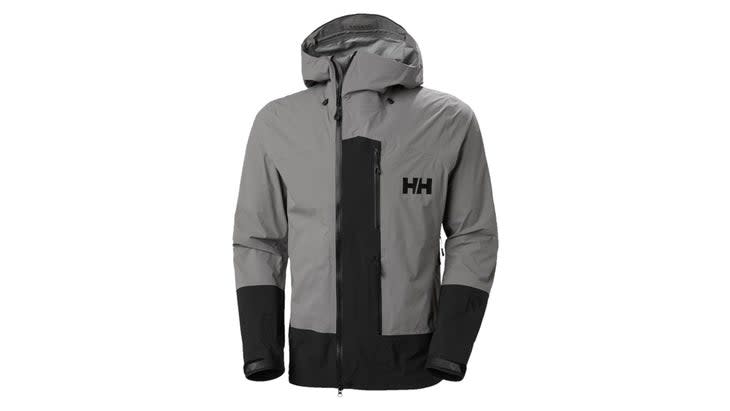
Weight: 15 oz
Sizes: S-XXL
Pros:
Ultra lightweight
Super packable
Cons:
Simple design doesn't have many features
Hard to access the lower hand pocket with a pack on
Helly Hansen nailed it this year with their technical touring collection, and the new BC Infinity Jacket was our favorite shell to take on long missions above treeline. The lightweight three-layer polyamide shell features a thin and supple handfeel and impressive moisture-shedding properties, with a packable design that rolled down smaller than a 32 oz. water bottle. "I wore this on back-to-back ski mountaineering missions in Grand Teton National Park totaling over 12K of vert," said tester Max Ritter. "It was exactly the jacket that I needed to stay warm and protected from the summit wind, and the fitted design is great for skiing with a pack." The unique look of the offset zipper design threw us at first, then grew on us throughout the season, and the streamlined pocket design--which featured two front pockets stacked on top of each other--made it easy to access the chest pocket but a little harder to access the hand pocket while wearing a pack.
Bottom line: A lightweight yet protective shell for weight-conscious skiers
Best Resort/Backcountry Crossover: The North Face Summit Men's Tsirku GTX Pro Jacket ($800)
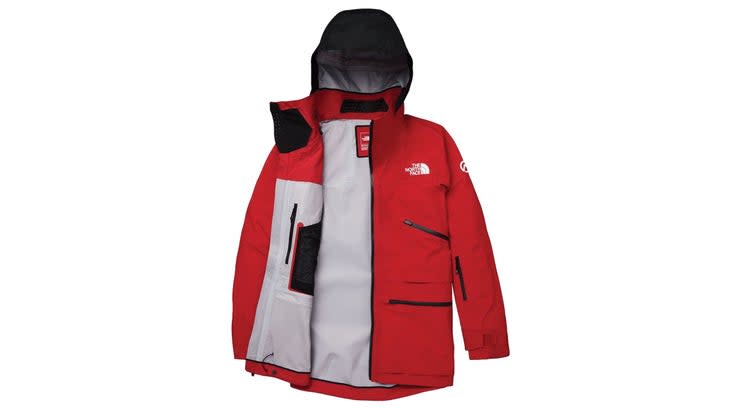
Weight: 1.1 lbs
Sizes: S-XXL
Pros:
Long hem provides ample protection
Ample pockets
Cons:
Bulky and less packable
Less breathable
Named after a glacial river in Haines, AK, it's no wonder the Summit Tsirku GTX Pro Jacket brushed off wet heavy storms without ever wetting out. "I spent six hours full-on storm skiing in this shell, and never felt so protected," said tester Lily Krass. "The long design doesn't let any snow or moisture sneak in." Testers felt the long freeride fit of the robust 80-denier woven nylon shell (which features a Gore-Tex Pro membrane); much appreciated for layering puffy jackets underneath on frigid midwinter tours, but a little bulky for spring missions. The roomy hood cinched up cozily over a helmet, and the articulated shoulders provided smooth mobility with a heavy pack on. This was our top choice for folks looking for one shell to rule them all, easy to transition between the resort and backcountry.
Bottom line: A robust crossover shell ideal for skiing a mix of resort and backcountry
Best For Storm Skiing: Rab Khroma Diffuse GTX ($525)

Weight: 22 oz.
Sizes: S-XXL
Pros:
Impressive storm protection
Spacious hood fits over a helmet
Cons:
Bulky
We hid from dozens of storms underneath Rab's new Khroma Diffuse Jacket, and came out no worse for the wear when battling our way through whiteouts and historic winter snowfall. Built with a Gore-Tex Pro membrane and a recycled polyamide face fabric, this bulletproof jacket was our go-to for the uber deep multi-lap pow days, a layer we could count on even when the snow turned to rain one day on Washington's Snoqualmie Pass. This jacket doesn't stand out for packability, but makes up for it in moisture and wind-cutting chops. "I took it out on some very wet storm days and the length of the jacket and size of the hood provided much appreciated coverage in harsh snow and wind," said Idaho-based tester Kailey Mckenna. "Put it on and you don't have to worry about it." Three external chest pockets were easy to reach into with a backpack and harness on, and the long hem added even more protection over our rear ends for days when the moisture just kept coming.
Bottom line: Storm day protection that you can count on, this jacket is ideal for folks traveling in zones with tons of precip
Women's Jackets
Best For Dry Climates: Orage Boulder Hybrid Jacket ($630)
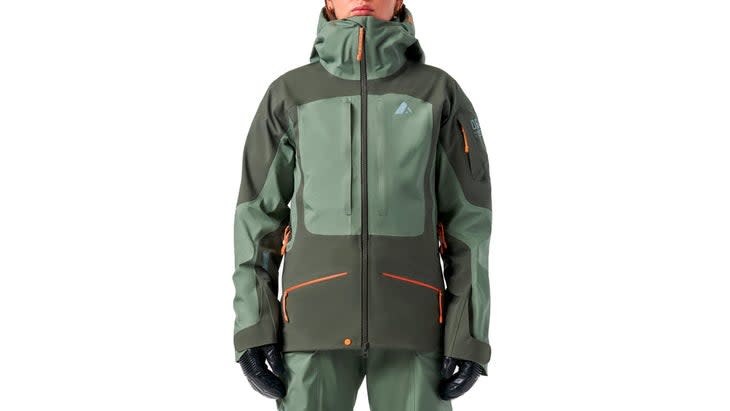
Weight: 21.5 oz.
Sizes: XS-XL
Pros:
Breathability
Wind protection
Cons:
Doesn't stand up to wet storms as well
Hardshell protection with a softshell feel, this jacket was so easy to move in, making the Boulder Hybrid Jacket our favorite shell for big tours in dry climates like the Rockies. A robust Oeko-Tex membrane combined with a recycled polyester face fabric shed snow and dumped moisture while we hunted for powder on storm days, and the soft jersey backing made it feel more like a midlayer than a burly shell. We were impressed with how well it cut wind, which came in handy on breezy Colorado summits. "A great layer for going uphill on cold days," said Telluride-based tester Robin Kondracki. "Maybe too light for wet storms, but otherwise really versatile." Deep chest pockets and lower hand pockets stashed all the snacks we needed for a three-hour climb in Grand Teton National Park, making it easy to reach for a bar or energy chews without taking our packs off.
Bottom line: A great all-around touring shell for drier climates like the Rockies that see a lot of low-density snow and minimal rain.
Best For Wet Climates: Mountain Hardwear Routefinder Gore-Tex Pro Jacket ($700)
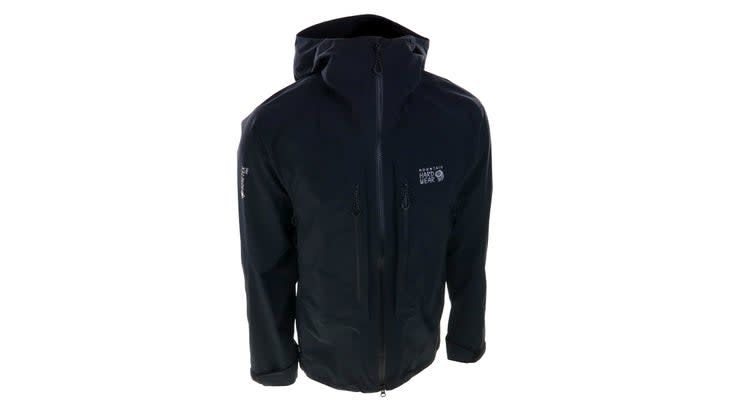
Weight: 1.2 lbs
Sizes: XS-XL
Pros:
Large chest pockets
Weather proofing
Cons:
Bulky
Burly and ready for any storm we walked into, Mountain Hardwear's Routefinder Jacket gained our trust while skiing the deepest powder of our lives, and it delivered. The three-layer Gore-Tex Pro membrane combined with an 80-denier nylon shell repelled snow, sleet, graupel, and unfortunate bouts of springtime rain. "I felt like I could walk through a car wash in this shell," said tester Lily Krass. Features are streamlined yet functional; the hood fit cleanly over a helmet and goggles, with enough of a brim to block heavy snowfall and spacious chest pockets that are easy to reach into while wearing a pack. "I liked how big the chest pockets were for a small notepad, phone, and snacks," said Jackson-based tester Molly Belk after a long day in the field digging snow pits. "I also was able to keep it on during short climbs in the backcountry outside Jackson Hole Mountain Resort." The only drawback we found was that it doesn't pack down as well as some of the other jackets we tested (it definitely runs large and features a slightly boxier fit), but it made up for that in breathability since we often scaled entire bootpacks without taking it off.
Bottom line: A burly shell for tackling storms head-on, this shell suits climates that see heavy amounts of snowfall.
Most Packable: Arc'teryx Alpha Jacket ($700)
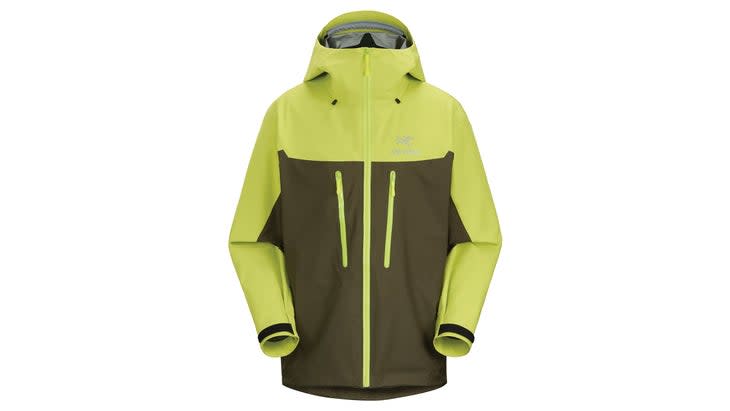
Weight: 11.6 oz
Sizes: XXS-XXL
Pros:
Packability
Lightweight
Cons:
Slightly less durable
Previously the Alpha AR, the updated Alpha Jacket has been updated with Arc'teryx's proprietary Hadron LCP fabric to bump up the breathability and shed weight. The ultralight gridded nylon face fabric was placed in low-wear areas (basically everywhere but the shoulders and arms), and that, combined with a Gore-Tex membrane, made for impressively light storm protection. "I love how thin this jacket feels, which makes it easy to move in and stuff in my pack," said tester Lily Krass. "But despite the featherweight design, it stood up to wet PNW storms no problem." The Alpha fit fairly slim but was still roomy enough for one 5'8" tester to fit two mid layers underneath a women's small, and easy-to-reach pit zips allowed us to dump heat mid stride on a 20-degree storm day in the Tetons without stopping to fully peel a layer. The Hadron fabric did feel easier to scuff up than some of the other bombproof shells we tried this winter, but the reinforced shoulders and arms in areas where it truly counted made up for it.
Bottom line: An ultra-packable, lightweight shell for long tours and spring objectives.
How To Buy
No matter what kind of fancy tech your outerwear has, the best backcountry jacket is the ones that fit you and your style best. Here are a few tips for finding the jacket that works best for you. And whatever you do, find a way to try jackets on before committing; brand sizing is across the board, so the only way to really know is to get products in your hands.
All of the jackets in this category are shells (non insulated) but there is still quite a range of weight and warmth. Compare product weights as well as fabrics; some heavier membranes, like Gore-Tex Pro, are ideal for wetter climates but may be overkill for dry days in the Rockies. Unless it's nuking snow, you'll likely be storing your jacket in your pack for a long climb, so it's worth noting how well it packs down and how strapped you are for space in your pack.
Pay attention to the features. Some jackets have a more streamlined design with only a few pockets, and others are chock full of nooks and crannies for your snacks and gear. If you want something you'll also take into the resort, a pass pocket on the arm, and a few hand and chest pockets can be nice for a crossover piece. Otherwise minimalists who just want a waterproof layer to throw on at the top might be content with a more simple design.
How We Test
Number of testers: 19
Number of products tested: 31
Number of miles skied: 1,200
Number of vertical feet skied: 410,000
Overnight ski tours: 8
Peaks bagged: 16
Deepest storm day total: 49 inches
Longest single day ski tour: 8,600 vertical feet
From high alpine peaks to low-angle pow laps, our team of 19 skiers tested 31 jackets last season, evaluating each piece for its breathability, durability, protection, and features. Testers spanned the gamut from vert-crazed uphill fiends to downhill-inclined freeride skiers, newer backcountry skiers, and everything in between. Jackson, Wyo. was our hub for testing this year, the perfect place to put jackets through the wringer on both deep storm days and high pressure windows in the alpine. Testers also took these layers for a spin in maritime climates like the Pacific Northwest and Interior British Columbia, as well as the high peaks of Colorado's San Juans and steep slopes in Southeast Alaska. We slogged up steep bootpacks, meandered along skintracks, walked knife-edge ridges, scored deep powder turns, smeared spring corn, and fought our way down variable wind crust to bring you the best backcountry jackets of the year.
Meet Our Lead Testers
Lily Krass is a freelance storyteller based in Jackson, Wyo., with a love for long days in the backcountry. In addition to an all-consuming addiction to powder skiing and exploring high places on skis, Lily takes snacking seriously, and when she's not writing or sliding on snow, she's likely deep into a baking project in her tiny kitchen. She is the co-author of Beyond Skid: A Cookbook For Ski Bums, a collection of dirtbag-friendly recipes inspired by life in a mountain town.
Other testers include Jackson, Wyo.-based Max Ritter, Lucy Iselin, Kailey McKenna, Molly Belk, and James Temple, who spent dozens of days going after big lines in Grand Teton National Park, sniffing out the deepest powder days on Teton Pass.
More From the 2024 Winter Gear Guide
The Best Backcountry Skis of 2024
The Best Backcountry Ski Boots
The Best Backcountry Ski Packs
For exclusive access to all of our fitness, gear, adventure, and travel stories, plus discounts on trips, events, and gear, sign up for Outside+ today.

